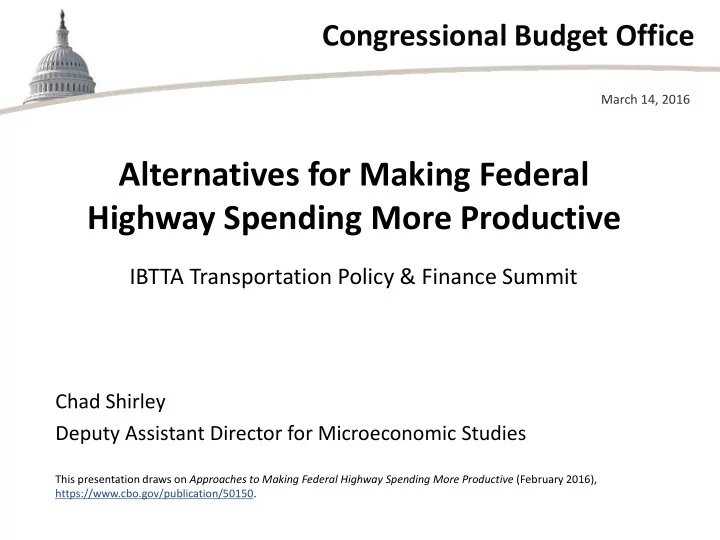

Congressional Budget Office March 14, 2016 Alternatives for Making Federal Highway Spending More Productive IBTTA Transportation Policy & Finance Summit Chad Shirley Deputy Assistant Director for Microeconomic Studies This presentation draws on Approaches to Making Federal Highway Spending More Productive (February 2016), https://www.cbo.gov/publication/50150.
The revenues from gasoline and diesel fuel taxes dedicated to the Highway Trust Fund—the federal government’s main source of funds for highways—have been insufficient to pay for highway spending. 1 CONGRESSIONAL BUDGET OFFICE
The Highway Trust Fund’s Outlays, Receipts, and Transfers Billions of Dollars 2 CONGRESSIONAL BUDGET OFFICE
The amount of federal spending for highways, as well as the amount of spending by all levels of government, has declined since the early 2000s when adjusted for changes in the cost of materials and other inputs. 3 CONGRESSIONAL BUDGET OFFICE
Spending for Highways Billions of 2014 Dollars 250 200 Federal, State, and Local Spending 150 100 Federal 50 Spending 0 1956 1961 1966 1971 1976 1981 1986 1991 1996 2001 2006 2011 4 CONGRESSIONAL BUDGET OFFICE
The allocation of federal highway funding is only loosely related to how much highways are used. 5 CONGRESSIONAL BUDGET OFFICE
Traffic Congestion and Spending, by Type of Highway 6 CONGRESSIONAL BUDGET OFFICE
Pavement Condition and Spending, by Type of Highway 7 CONGRESSIONAL BUDGET OFFICE
Condition of Bridges and Spending, by Location and Bridge Class 8 CONGRESSIONAL BUDGET OFFICE
Highway Safety and Spending, by Type of Highway 9 CONGRESSIONAL BUDGET OFFICE
To make federal highway spending more productive for the economy, policymakers could adopt different approaches to managing highways and determining how to allocate funds, including: • Charging drivers, • Using benefit-cost analysis, or • Linking spending to performance. 10 CONGRESSIONAL BUDGET OFFICE
Charging Drivers 11 CONGRESSIONAL BUDGET OFFICE
Policymakers could have the federal government—or allow states or private businesses to—charge drivers directly for their use of more roads than they are currently charged for using. 12 CONGRESSIONAL BUDGET OFFICE
The Congress could incorporate more direct pricing of the use of roads in a number of ways, including: • Implementing vehicle-miles traveled charges, • Facilitating more congestion pricing, or • Allowing tolling on additional existing Interstates. 13 CONGRESSIONAL BUDGET OFFICE
Benefit-Cost Analysis 14 CONGRESSIONAL BUDGET OFFICE
Policymakers could use estimates of the economic benefits and the costs of spending for particular programs or highways and reallocate spending to programs or projects with benefits for the economy greater than their costs. 15 CONGRESSIONAL BUDGET OFFICE
Changes in Spending Suggested by the FHWA’s Benefit-Cost Analysis If Total Spending Was Held Constant 16 CONGRESSIONAL BUDGET OFFICE
Linking Spending to Performance 17 CONGRESSIONAL BUDGET OFFICE
Policymakers could link spending more closely to measures of the performance of the highway system that have implications for the economy—such as ones for traffic congestion or road quality—by providing additional funds to states that meet certain standards or reducing funding for states that do not. 18 CONGRESSIONAL BUDGET OFFICE
Spending to Repair Pavement per Vehicle-Mile Traveled Percentage of Road Miles With Poor Pavement Quality 19 CONGRESSIONAL BUDGET OFFICE
Recommend
More recommend